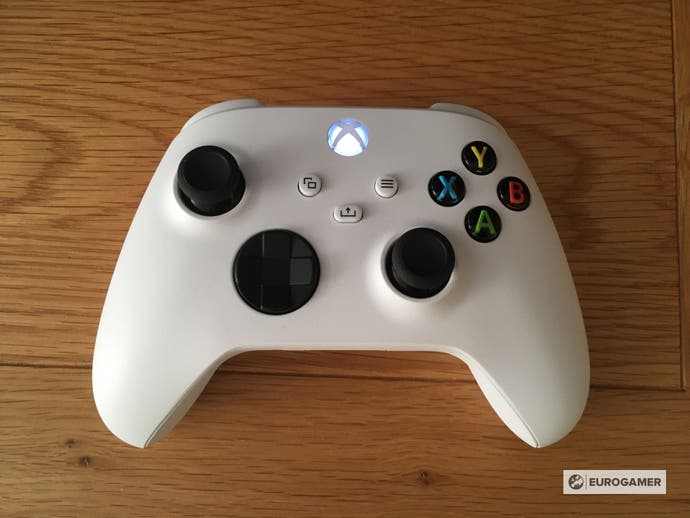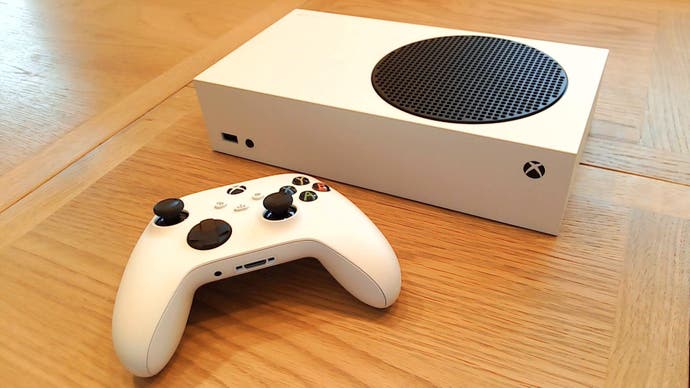Xbox Series S impressions: good things come in 364GB packages
Library Pass.
"Thank goodness you're finally getting rid of that", my flatmate said as I hunched over our TV cabinet, mid-way through the ceremonial process of changing out my Xbox One for the Series S. A little harsh on the poor old Xbox One, perhaps, but I could understand the sentiment. Demanding a large amount of horizontal space - and by this point in the generation struggling to keep up with more demanding titles - I'd begun to neglect it in favour of the bright RGB lights of PC gaming.
In its place now rests a compact white box, and an altogether different vision to what Microsoft presented at the start of the previous generation. The digital-only Xbox Series S is the smallest console Microsoft has ever produced, and probably the most affordable. Coming in at £249, it's even undercut the Nintendo Switch by £30. It's a staggeringly accessible gateway to next-gen gaming, all for £200 less than a Series X: but the question is whether you're willing to pay for it in a lower max resolution, reliance on digital downloads, and - crucially - only 364GB of usable space for games and apps. Perhaps more than anything, the Series S requires a shift in the way we consume our games, encouraging a high turnover of a few titles at a time rather than storing dozens away for a rainy day.
I'm by no means a hardware specialist (and I'll leave the in-depth performance analysis in the very capable hands of Digital Foundry), so like our Xbox Series X impressions written by Chris Tapsell, consider this more an account of what it's like to live with a Series S. And despite some concerns about storage, I will say this: the Series S has made me more excited for console gaming than I have been in a very long time.
As the saying goes, you shouldn't judge a book by its cover, but in the case of the Series S that cover looks extremely good. It's about the size of a large hardback - probably one of those dense university law books you weren't allowed to borrow - and can be slotted either vertically or horizontally in a TV cabinet, with the reduced size opening up more room for ventilation. Yet it would be a shame to hide it away, as the monochrome design is sleek enough to make the console eye-catching without being overwhelming. The matching controller hasn't undergone massive design changes (the main additions being quality of life improvements like a share button and revamped d-pad, along with reduced latency), but I really like the new textured grip, which just reminds me where the controller is, particularly if my fingers have moved after watching a cutscene.




I needed a smaller game to get things started while I waited for larger downloads, so strangely enough, the first title I played was the 10-year-old Fallout: New Vegas. The impact of next-gen tech on Series S is perhaps most noticeable with backwards compatibility, with stable frame rates and crisp visuals bringing it closer to the quality of my PC version. I mostly played on a Panasonic Plasma that didn't support 4K or HDR (unlike the Series X the S doesn't support native 4K resolution for games at 120fps, and instead mainly targets 1440p with up to 120fps), but even without these it's a much-improved console experience - particularly with newer titles running at 60fps.
I did later test the console on a 120hz screen to check out the 120fps versus mode against AI on the optimised Gears 5, and if you're looking for another real next-gen experience, this is certainly it. I felt like I was suddenly wearing glasses when turning, with a huge reduction in blur that's immensely useful for orienting yourself and quickly locating enemies. I also found myself looking down at my Series S in awe, surprised that the little thing could achieve this. It would be great to see the 120fps option in more multiplayer games, but I wonder whether this is actually going to be widely adopted, or remain more of a next-gen showcase in a few modes.
Yet the thing that shocked me most - and the real game-changer this generation - is the sheer speed of the Series S. It's one thing to read about it on paper, and another to experience just how zippy it is in person, even if it's just gliding through menus with ease. It took me only 18 seconds to get to Warzone's multiplayer menu (which involved connecting to Xbox Live with my mediocre internet speed). Fallout New Vegas took 17 seconds to load, but more importantly its in-game loading screens were rendered practically non-existent. Which is hugely useful in a game where fast travel is such a major mechanic.
The feeling of speed can also, of course, be found in the Quick Resume feature. In the build-up to next-gen I wondered just how much I would use this, and as someone who tends to focus on one game at a time, I couldn't see myself hopping between several at once. That changed with the Series S, simply due to the ease of doing so. I practically gave myself whiplash from jumping between the Mojave wasteland and the sodden fens of The Witcher 3. It also meant I could start one game, dip out to use YouTube, then return to a different game without hesitation. On another occasion, I booted up my Xbox and was able to instantly resume any of the three games I had been playing in my previous session - so it's not just about jumping between games. Maximising time spent in-game seems to be the focus for both PlayStation and Xbox this generation, and it's something I think is particularly important for console gaming. As someone all-too familiar with the faff of launchers and menus on PC, it's refreshing to just sit down, pick up a controller and get stuck in.

So, time to discuss the catch. For one thing, you don't get the 4K resolution for games offered by the Series X, and there's a suggestion some developers will struggle to implement ray tracing on the smaller console (again, wait for Digital Foundry analysis on this). But the real kicker is storage. The Series S has a 512GB SSD, but only 364GB of this remains available for games and apps - the rest is taken up by the operating system. Strangely enough, this means the Series S actually has 1GB less available space than the base Xbox One, which has 365GB. To demonstrate what this looks like, here's a screencap of my library, with no captures and only YouTube and Xbox Insider Hub in the form of optional apps, and 28.5GB left in spare space:

Things are a little more complicated than they may first appear, however. Microsoft has said install sizes will be smaller on the Series S as 4K resolution textures are not required (via IGN). And indeed, that appears to be true for some games: on current-gen Xbox One, Forza Horizon 4 clocks in at 84.6GB and Gears 5 reaches 76.4GB. On Xbox Series X it's 81.9GB for optimised Forza and 71.9GB for optimised Gears, and for the optimised versions on Xbox Series S, it's 71.4GB for Forza and 55.12GB for Gears. That's promising, but I wonder if it's enough to compensate for a broader increase in the size of games over the next few years - Call of Duty: Warzone, for instance, is already a chunky 106.4GB on Series S.
Meanwhile, it seems not all games will be smaller on the S. Black Ops: Cold War was yesterday announced to be 136GB on both Series X and S - 43GB more than the Xbox One version. If you want to pack out your library with fresh AAA behemoths, you might find yourself hitting the storage limits more often than you'd like. Unless you're willing to pay £220 for a 1TB Seagate expansion card, at which point you might as well get the Series X.

Although this could be trouble further down the line, for now I think it's a manageable amount of space, and less of an issue if you're looking for a mix of retro and indie titles. It's another reason why you may want to think carefully about your internet speed, as you'll probably need to rotate your library a little more frequently. In a way, this does align quite well with Game Pass - you can think of the Series S almost like a library card on which you can withdraw a certain number of books at a time, and return ones you're not using or don't like. It's a new approach to consuming games that I've actually quite enjoyed. Rotating through Game Pass has already made me discover that I do like driving games, actually, after trying out Forza Horizon 4 and finding myself hooked. Looking back at my Steam library of shame, perhaps the more limited space on the Series S could push me to play all the games I've installed. Even without a glamorous line-up of new launch titles, exploring revitalised older games on Game Pass with next-gen improvements has somehow become exciting.
The storage situation may be irritating for some, I'm sure, but when you look at the price and size of the Series S, it's hard to get too mad at it. That £249 price tag future-proofs you for next-gen titles, and gives you most of Xbox's next-gen features for nearly half the price of the X. For those uncertain about making the leap, it's a great way to test next-gen out, and the Seagate expansion is available should you need more storage later on. The Series S isn't built purely for those who consider themselves hardcore gamers: it's for those buying their first console, those looking for a second platform, or those returning to console gaming after a long break. It's a zippy little box that's managed to tempt me back downstairs to couch and controller. And I just think it's neat.


